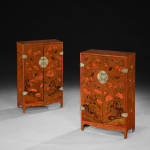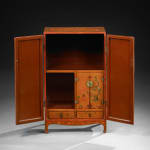Cabinets & Desks
A PAIR OF LATE 17TH, EARLY 18TH CENTURY RED LACQUER SIDE CABINETS
Width: 51.5 cm
Depth: 25.5 cm
Height 84 cm.
Provenance
Private Colelction: France, Paris
Private Collection UK, London
Literature
Clunas, Craig. Chinese Furniture. Victoria and Albert Museum, 1988.
Soame Jenyns. Chinese Art: Lacquer, Glass and Cloisonné. Victoria and Albert Museum, 1950.
Zhongguo meishu quanji: Qiqi bian [The Great Treasury of Chinese Fine Arts: Lacquerware]. Beijing, 1989.
Béatrice Quette (ed.). La Laque en Chine. Musée des Arts Décoratifs / Somogy, 2013.
Compare with examples discussed in Craig Clunas, Chinese Furniture (V&A, 1988), and Béatrice Quette (ed.), La Laque en Chine (2013), which document similar uses of polychrome lacquer and auspicious motifs. See also Watt and Ford, East Asian Lacquer (Metropolitan Museum of Art, 1991) for the stylistic and technical parallels, particularly in cabinets incorporating engraved and coloured lacquer techniques (qiangjin and tianqi).
A Rare Pair of Late 17th - Early 18th Century, Chinese Red Lacquer Cabinets with Polychrome Decoration
Chinese: Qing Dynasty, Kangxi Period (1662-1722) / Yongzheng Period ( 1723-1735)
Refinement and Form
This rare pair of lacquer cabinets exemplifies the refinement and artistry of Chinese lacquer work at the turn of the 18th century. Each cabinet is intricately decorated with incised linework enriched with polychrome pigments and gilding. They survive in fine condition throughout, retaining their original brass fittings, including ruyi-shaped lockplates, strap hinges, and loop hasps.
Painterly Decoration and Symbolism
The doors are adorned with sprays of flowering peach branches and brightly coloured parrots perched amidst the foliage. Outlined and filled with pigments and touches of gold, these motifs carry auspicious meanings in Chinese culture: peaches symbolise longevity and immortality, while parrots suggest eloquence and refinement.
A Rare and Refined Interior
Opening the double doors reveals an unusually sophisticated interior arrangement, underscoring the cabinets’ dual function as practical storage and decorative showpieces. Each contains an upper compartment with a single shelf, and beneath, a pair of smaller interior doors painted with red and green dragons—emblems of imperial power.
Rarity and Historical Significance
Dating from the late 17th to early 18th century, these Kangxi-period cabinets are distinguished by their superb quality of construction and decoration. Their survival as a pair further enhances their rarity, while their preserved condition and original fittings mark them as exceptional examples of Qing lacquer furniture.



